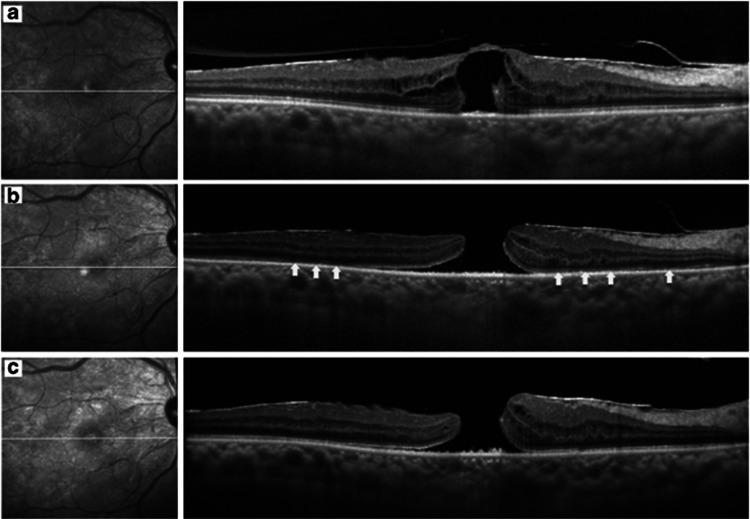Sir,
Ocriplasmin is a recombinant protease recently approved for the treatment of symptomatic vitreomacular adhesion (VMA). According to its FDA label, in the clinical trials of ocriplasmin, 2% of subjects experienced dyschromotopsia following its administration. In approximately half of these cases, there were electroretinographic (ERG) changes reported (a- and b-wave amplitude decrease).1 We describe a 67-year-old woman with a macular hole and VMA who received ocriplasmin and subsequently developed transient vision loss. Using eye-tracked spectral-domain optical coherence tomography (SD-OCT), we demonstrate that this vision loss appears to correlate with the disruption of the photoreceptor outer segments.
Case report
A 67-year-old female presented with a recent change in vision in her right eye. On presentation, visual acuity was 20/100 in her right eye. Clinical examination and SD-OCT showed a VMA, an epiretinal membrane, and a macular hole involving all but the inner retinal layers (Figure 1a). One week following intravitreal ocriplasmin (0.125 mg/0.1 ml), visual acuity had decreased to 20/400. Eye-tracked SD-OCT showed resolution of the VMA, a full-thickness macular hole, and damaged photoreceptor outer segments indicated by marked disruption of the ellipsoid zone (Figure 1b). Three weeks later, visual acuity had improved to 20/50. Eye-tracked SD-OCT showed persistence of the macular hole with a marked improvement in the integrity of the ellipsoid zone, indicative of partial recovery of photoreceptor outer segments (Figure 1c).
Figure 1.
Eye-tracked spectral-domain optical coherence tomography immediately before (a), 1 week following (b), and 4 weeks following a single intravitreal injection of ocriplasmin (c). (a) Before treatment, there is a vitreomacular adhesion (VMA), an epiretinal membrane, and a macular hole involving all but the inner retinal layers. (b) One week following treatment, there is resolution of the VMA, a full-thickness macular hole, and damaged photoreceptor outer segments indicated by marked disruption of the ellipsoid zone (arrows). (c) Four weeks following treatment, there is persistence of the macular hole with a marked improvement in the integrity of the ellipsoid zone.
Comment
In the clinical trials of ocriplasmin, blurred vision, photopsia, dyschromotopsia, and ERG changes occurred in a significantly greater number of patients receiving ocriplasmin vs those receiving a placebo (drug vehicle diluted with saline).1, 2 These ocular adverse events appear to suggest a drug effect on the neurosensory retina, most likely involving the photoreceptors. The SD-OCT findings in our case appear to support this mechanism. We propose that in some eyes, ocriplasmin, a proteolytic enzyme, may produce a disruption of the photoreceptor outer segments that is at least partially reversible. Determining whether ocriplasmin, a protein with a molecular weight of 27.2 kDa, reaches the photoreceptors through the macular hole or via a trans-retinal route might help predict which eyes are at higher risk for this complication.
Acknowledgments
This study was supported in part by the Macula Foundation, Inc. The funding organization had no role in the design or conduct of this research.
KBF is the consultant (H) at the Heidelberg Engineering and ThromboGenics. SAS and VPS declare no conflict of interest.
References
- JETREA (package insert). ThromboGenics Inc.: Iselin, NJ2012
- Stalmans P, Benz MS, Gandorfer A, Kampik A, Girach A, Pakola S, MIVI-TRUST Study Group et al. Enzymatic vitreolysis with ocriplasmin for vitreomacular traction and macular holes. N Engl J Med. 2012;367 (7:606–615. doi: 10.1056/NEJMoa1110823. [DOI] [PubMed] [Google Scholar]



